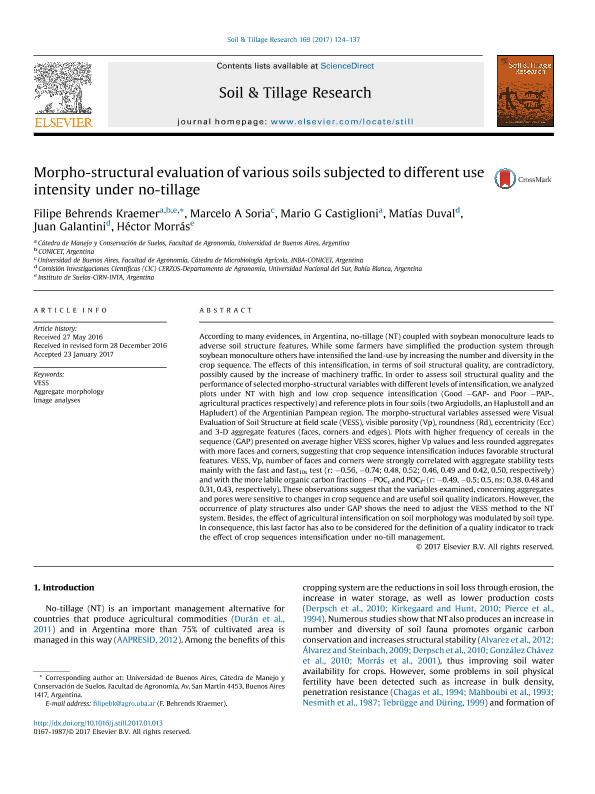Mostrar el registro sencillo del ítem
dc.contributor.author
Behrends Kraemer, Filipe

dc.contributor.author
Soria, Marcelo Abel

dc.contributor.author
Castiglioni, Mario Guillermo

dc.contributor.author
Duval, Matias Ezequiel

dc.contributor.author
Galantini, Juan
dc.contributor.author
Morrás, Héctor José María

dc.date.available
2017-07-13T19:20:24Z
dc.date.issued
2017-06
dc.identifier.citation
Behrends Kraemer, Filipe; Soria, Marcelo Abel; Castiglioni, Mario Guillermo; Duval, Matias Ezequiel; Galantini, Juan; et al.; Morpho-structural evaluation of various soils subjected to different use intensity under no-tillage; Elsevier Science; Soil & Tillage Research; 169; 6-2017; 124-137
dc.identifier.issn
0167-1987
dc.identifier.uri
http://hdl.handle.net/11336/20388
dc.description.abstract
According to many evidences, in Argentina, no-tillage (NT) coupled with soybean monoculture leads to adverse soil structure features. While some farmers have simplified the production system through soybean monoculture others have intensified the land-use by increasing the number and diversity in the crop sequence. The effects of this intensification, in terms of soil structural quality, are contradictory, possibly caused by the increase of machinery traffic. In order to assess soil structural quality and the performance of selected morpho-structural variables with different levels of intensification, we analyzed plots under NT with high and low crop sequence intensification (Good −GAP- and Poor −PAP-, agricultural practices respectively) and reference plots in four soils (two Argiudolls, an Haplustoll and an Hapludert) of the Argentinian Pampean region. The morpho-structural variables assessed were Visual Evaluation of Soil Structure at field scale (VESS), visible porosity (Vp), roundness (Rd), eccentricity (Ecc) and 3-D aggregate features (faces, corners and edges). Plots with higher frequency of cereals in the sequence (GAP) presented on average higher VESS scores, higher Vp values and less rounded aggregates with more faces and corners, suggesting that crop sequence intensification induces favorable structural features. VESS, Vp, number of faces and corners were strongly correlated with aggregate stability tests mainly with the fast and fast10s test (r: −0.56, −0.74; 0.48, 0.52; 0.46, 0.49 and 0.42, 0.50, respectively) and with the more labile organic carbon fractions −POCc and POCf- (r: −0.49, −0.5; 0.5, ns; 0.38, 0.48 and 0.31, 0.43, respectively). These observations suggest that the variables examined, concerning aggregates and pores were sensitive to changes in crop sequence and are useful soil quality indicators. However, the occurrence of platy structures also under GAP shows the need to adjust the VESS method to the NT system. Besides, the effect of agricultural intensification on soil morphology was modulated by soil type. In consequence, this last factor has also to be considered for the definition of a quality indicator to track the effect of crop sequences intensification under no-till management.
dc.format
application/pdf
dc.language.iso
eng
dc.publisher
Elsevier Science

dc.rights
info:eu-repo/semantics/openAccess
dc.rights.uri
https://creativecommons.org/licenses/by-nc-sa/2.5/ar/
dc.subject
AGGREGATE MORPHOLOGY
dc.subject
IMAGE ANALYSES
dc.subject
VESS
dc.subject.classification
Ciencias del Suelo

dc.subject.classification
Agricultura, Silvicultura y Pesca

dc.subject.classification
CIENCIAS AGRÍCOLAS

dc.title
Morpho-structural evaluation of various soils subjected to different use intensity under no-tillage
dc.type
info:eu-repo/semantics/article
dc.type
info:ar-repo/semantics/artículo
dc.type
info:eu-repo/semantics/publishedVersion
dc.date.updated
2017-07-12T18:16:31Z
dc.journal.volume
169
dc.journal.pagination
124-137
dc.journal.pais
Países Bajos

dc.journal.ciudad
Amsterdam
dc.description.fil
Fil: Behrends Kraemer, Filipe. Instituto Nacional de Tecnología Agropecuaria. Centro de Investigación de Recursos Naturales. Instituto de Suelos; Argentina. Universidad de Buenos Aires. Facultad de Agronomia. Departamento de Ingenieria Agricola y Uso de la Tierra. Cátedra de Manejo y Conservación de Suelo; Argentina. Consejo Nacional de Investigaciones Científicas y Técnicas; Argentina
dc.description.fil
Fil: Soria, Marcelo Abel. Universidad de Buenos Aires. Facultad de Agronomía. Departamento de Biología Aplicada y Alimentos. Cátedra de Microbiología Agrícola; Argentina
dc.description.fil
Fil: Castiglioni, Mario Guillermo. Universidad de Buenos Aires. Facultad de Agronomia. Departamento de Ingenieria Agricola y Uso de la Tierra. Cátedra de Manejo y Conservación de Suelo; Argentina
dc.description.fil
Fil: Duval, Matias Ezequiel. Consejo Nacional de Investigaciones Científicas y Técnicas. Centro Científico Tecnológico Conicet - Bahía Blanca. Centro de Recursos Naturales Renovables de la Zona Semiarida. Universidad Nacional del Sur. Centro de Recursos Naturales Renovables de la Zona Semiarida; Argentina
dc.description.fil
Fil: Galantini, Juan. Consejo Nacional de Investigaciones Científicas y Técnicas. Centro Científico Tecnológico Conicet - Bahía Blanca. Centro de Recursos Naturales Renovables de la Zona Semiarida. Universidad Nacional del Sur. Centro de Recursos Naturales Renovables de la Zona Semiarida; Argentina
dc.description.fil
Fil: Morrás, Héctor José María. Instituto Nacional de Tecnología Agropecuaria. Centro de Investigación de Recursos Naturales; Argentina
dc.journal.title
Soil & Tillage Research

dc.relation.alternativeid
info:eu-repo/semantics/altIdentifier/url/http://www.sciencedirect.com/science/article/pii/S0167198717300132
dc.relation.alternativeid
info:eu-repo/semantics/altIdentifier/doi/http://dx.doi.org/10.1016/j.still.2017.01.013
Archivos asociados
